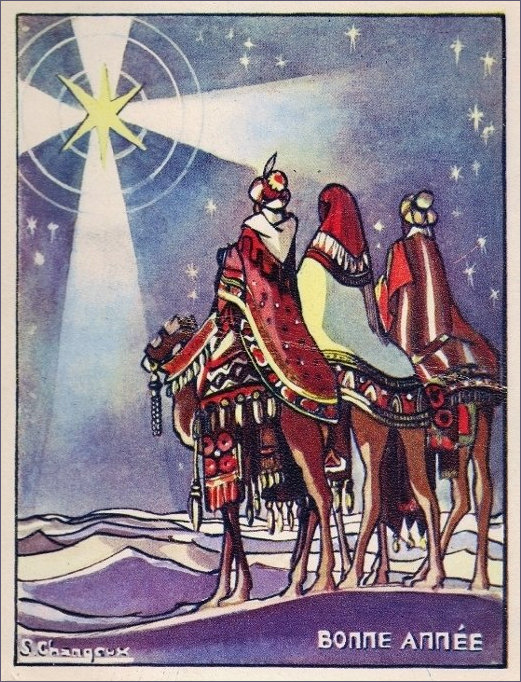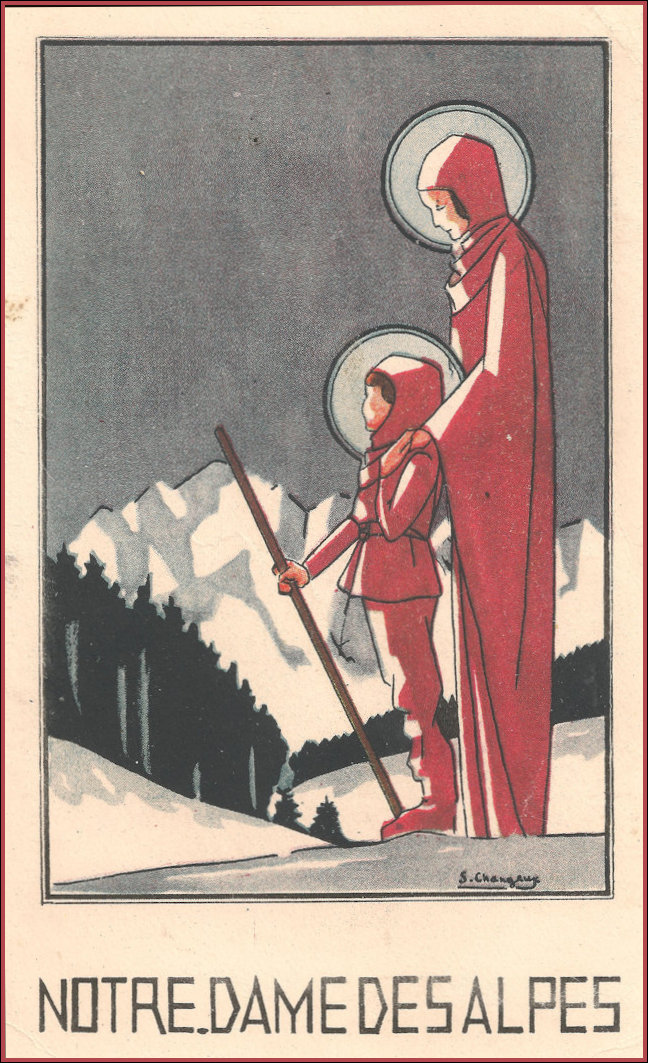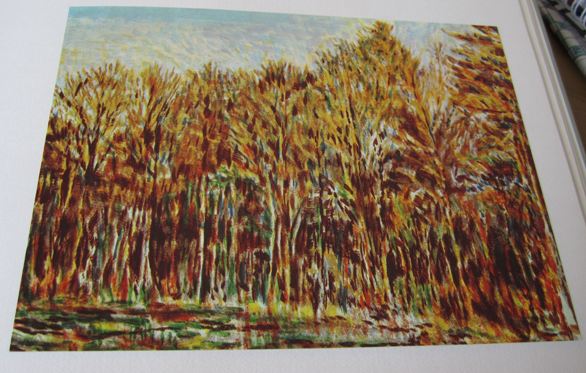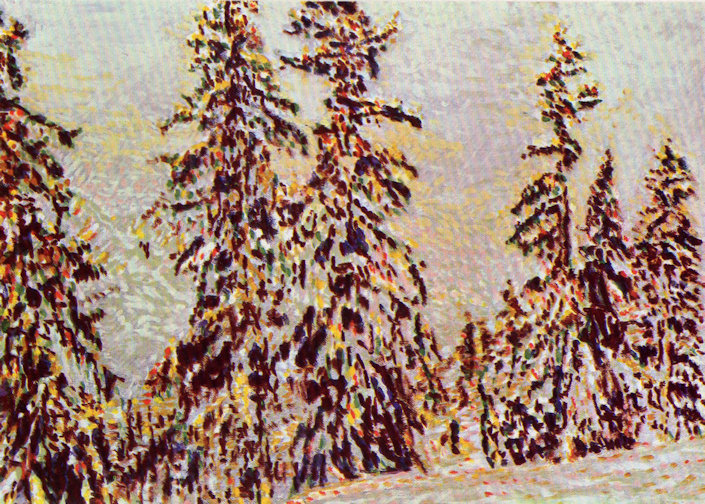Golon Books Home / Home Page / About Anne
Anne Golon - Illustrator


Beautiful images of the Magi on their way to Bethlehem and the Madonna of the Alps and whilst war raged in Europe 1940-1 by Anne Golon (Simone Changeux)
Anne and Serge Golon - Artists

The cover of the published book

An example of Anne's style

An example of Serge's style
Introduction
'Transcribed verbatim from Anne and Serge Golon Painters'
Serge and Anne Golon have acquired great fame by writing a number of books. With exceptional talent, indeed with a kind of genius, they have brought our novels that have been translated right away into many languages and have been made into films.
Serge Golon, the geologist, was in Africa when Anne, the journalist, came to interview him. It was a case of love at first sight, they were married, and thus came into being a strange and wonderful partnership. This was the beginning of 'Angélique' and of the series of works which they combined in writing and which have raised Serge and Anne to the top rank among writers of international fame.
Being passionately interested in acquiring knowledge of all kinds, they both took to the art of painting and began to produce pictures as a form of relaxation from the laborious task of wading through piles of documents.
Although Serge and Anne have become world-renowned as writers, their talents as painters are as yet unknown to the public. The time has come to bring them to the forefront.
We find ourselves in the presence of two eloquent artists each with his own particular way of making us appreciate his media and resources.
This booklet will enable us to get to know Serge and Anne Golon, whose pictures are so far from commonplace. They are in fact proof of constant research. Well worked-out ideas and much thought and meditation have gone into the creation of each finished picture.
Serge Golon brings us something new in his plastic (relief) interpretation of nature, which man has been endeavouring to define ever since the most ancient of days.
Indeed, into Serge Golon's pictures, which are apparently figurative and almost impressionistic in style, has gone an endless amount of extremely subtle and painstaking research, scientific research which has enabled his brush to portray with the utmost fidelity and sensitivity the world which he so much admires. Everything about his technique is new. So, his peintures are three-dimensional. Through the painter we can perceive the engineer feeling his way, manipulating his calculating instruments, carefully meting out each element. He starts from the dead, inert matter such as powder, oil paint, paste, chemical or mineral elements to come to the subject and to build it with 'every chance' of self-realisation. Serge Golon manufactured his own colours, just like the painters of yore, but, being a twentieth-century chemist, he can avail himself of all that modern science can offer. Therefore, it is no wonder that his media of expression in the realms of colour and relief are constantly being altered and renewed.
He is able to give us some really wonderful surprises. For instance, the same picture, examined under the light of an ultra-violet lamp, appears to us to be bathed in moonlight, that is it gives us a night-time view of the same sunny landscape that we have just been looking at one moment before in the light of day.
Relief can to a considerable extent be portrayed by the use of light and shade and of peculiar radiations of the physical components; a felling of distance is conveyed to us. We can see this in "The River Jordan" ("Le Jourdain"), where the water really appears to be receding into the reeds and papyrus without the painter's having to resort to the device of applying several layers of paint; this effect (the idea of relief) has been produced thanks to the disposition of colour splashes and to the application of transparent colours, In the "Valley of Gezräel" (La vallée de Gezräel"), the eye guesses, rather than it can actually see, the distant mountains of Syria which are not depicted but revealed through the orange touches of dancing light and through the more opaque veil of the heat mist. Even more elusive, and yet still more perceptible, is the valley which, behind "The Old Larches" ("Les vieux mélèzes"), can only just be imagined; nevertheless we can feel it across the snow-covered distance.
The sculptured skies of the "Autumn in Randogne" ("L'automne à Randogne") or "Sunset at Quiberon" ("Coucher de soleil à Quiberon") add a light movement to the steady lines of the mountains or rocks which appear to be dancing in the wind.
Serge Golon seems to have a special fondness for the forests of the world and can reproduce the light peculiar to each one. The maples of Switzerland, the elm-trees of Moscow, the spruces of Germany, and so on. Sometimes we gaze at them from the side of the lake (Derborence). Sometimes we get the feeling we are right under the trees. Out of the larch-trees at Derborence appears the figure of a shepherd walking. We see him, then suddenly he seems to disappear into the half-light, only to re-appear to us like the characters in "Chapelle romane d'Isny" (South Germany).
A great deal can be said about Serge Golon's works and also about those of Anne Golon. There is no similarity in their art, but there is something very appealing about this diversity of talents. The language used by one is quite different from that of the other. In any case we cannot remain unmoved by the canvasses of either of them for they are the work of artists of no uncertain talent. They will undoubtedly make themselves known through this art as they have done through that of novel-writing."
Personal observation - as an introduction to the work of two artists, this leans very heavily towards only one with the occasional reference to an equal partner! I cannot find a definitive dated point of reference, but as historically in the mid part of the 20th century we know there was quite a lot of discrimination against women and their 'selling' power, we will have to resign ourselves to this being yet another example!
To be continued .....
Serge Golon 'Old Larches at Crans-Montana' (Switzerland) referred to in the article above and is most likely the image by Anne Golon's side in my tribute 'Portrait of an ageless author.'
Back to Top / Golon Books Home / Home Page
Page under construction - refreshed 6th October 2020 (G)
